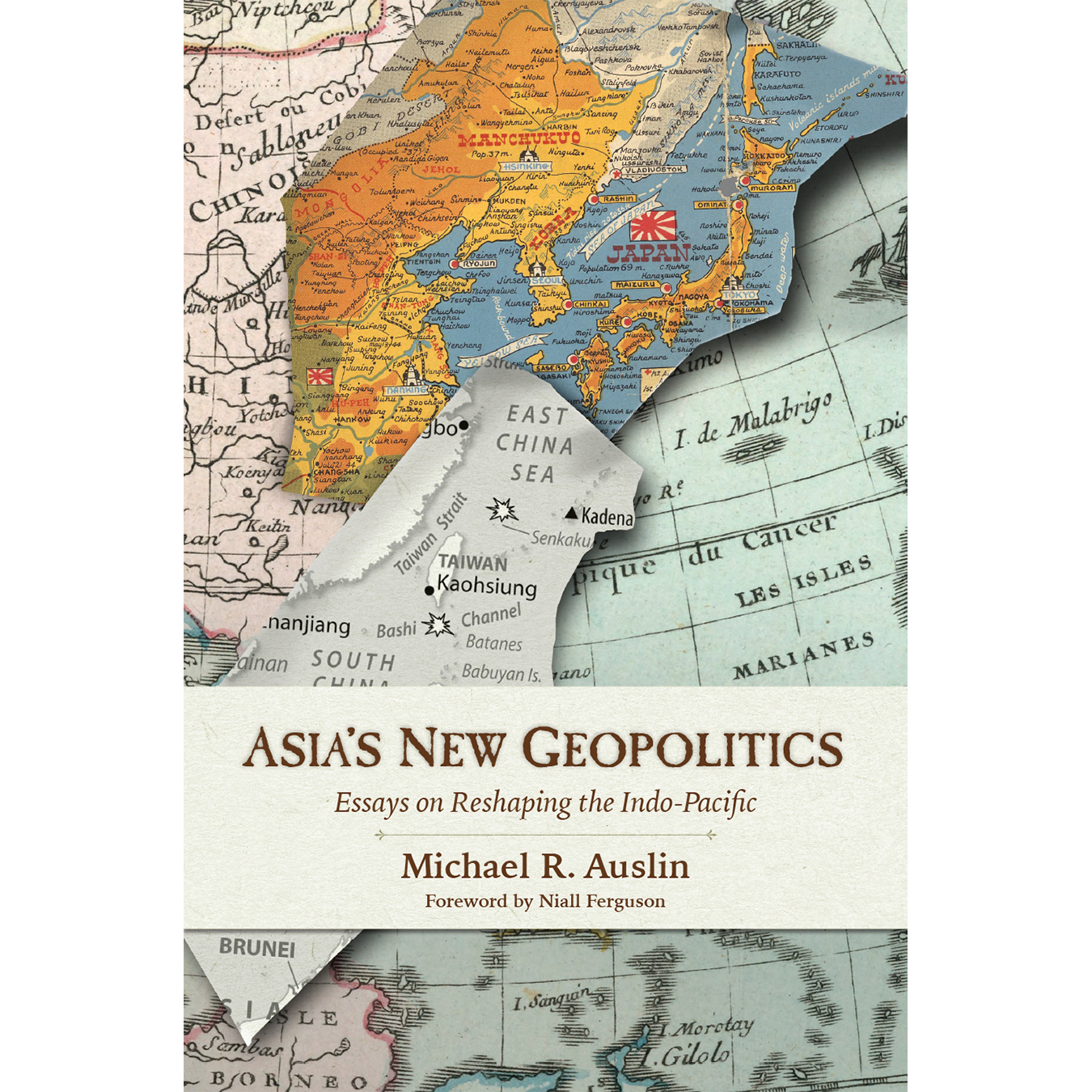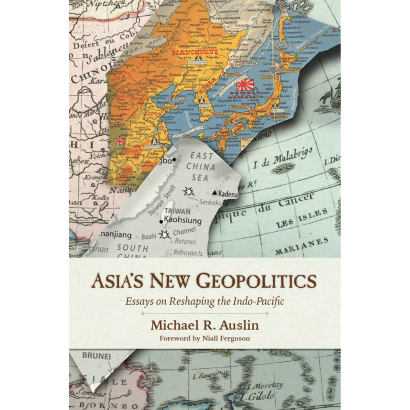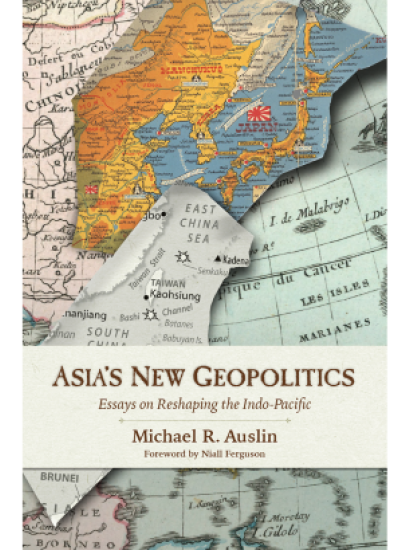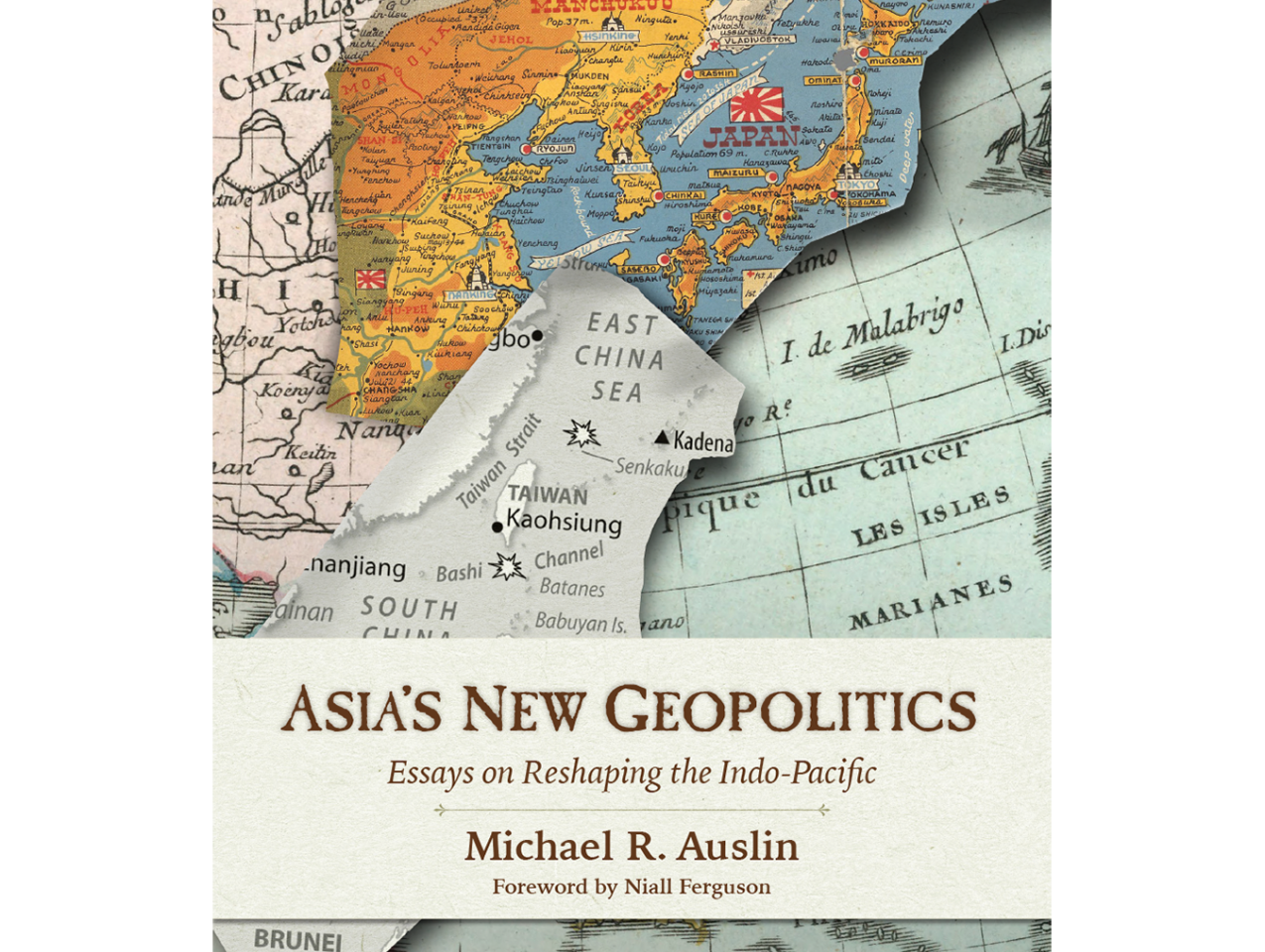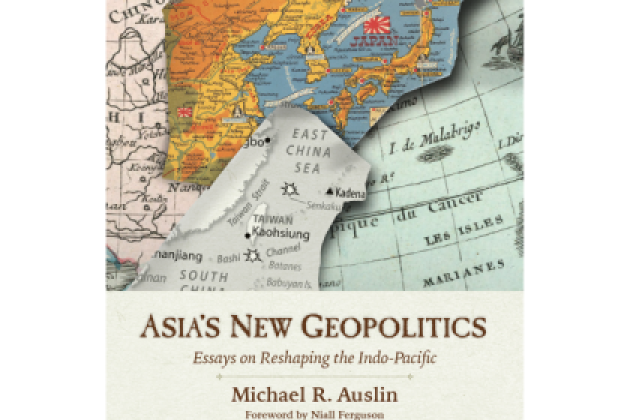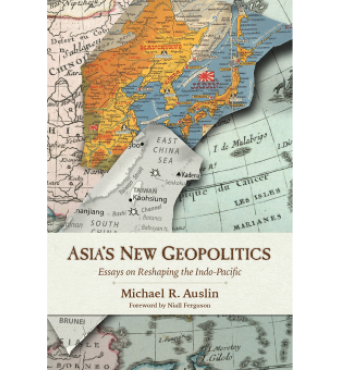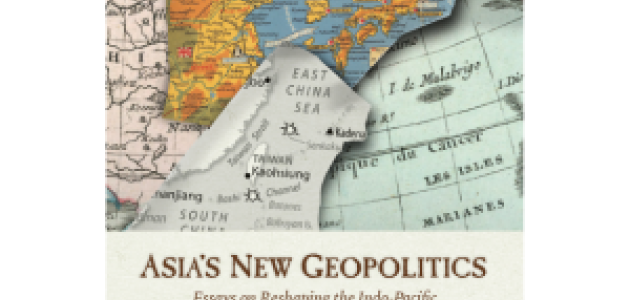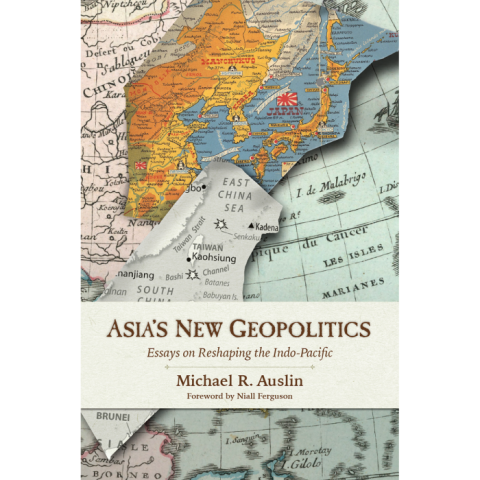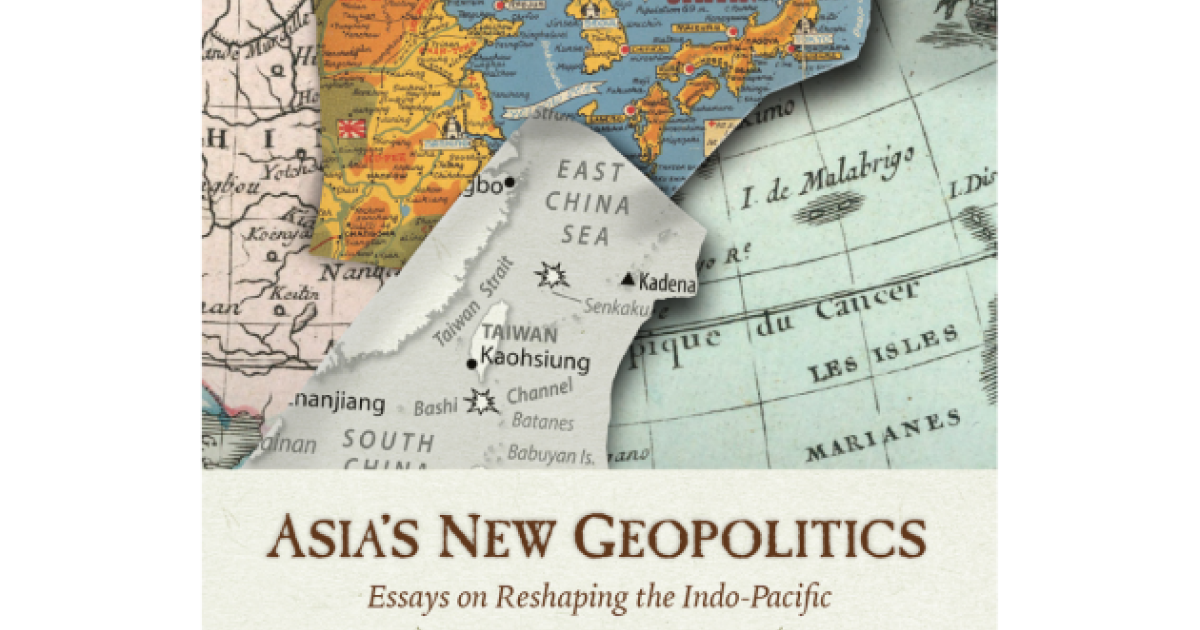by Jonathan Movroydis
In this interview, Michael Auslin, Payson R. Treat Distinguished Research Fellow in Contemporary Asia, discusses his newly released book by Hoover Institution Press, Asia’s New Geopolitics: Essays on Reshaping the Indo-Pacific.
Auslin describes the geopolitical importance of Asia’s inner seas and how the Indo-Pacific region is impacted by China’s ambitions, US force posture, North Korea’s quest for nuclear weapons, the Sino-Japanese competition, and India’s struggles as the world’s largest democracy.
What are the origins of this book project?
At the end of the Cold War, the United States believed that geopolitics was over, because it assumed Asia, particularly China, would follow a developmental path that we had seen with Japan, Korea and Taiwan. We believed that as Asian nations modernized and became economically and politically integrated with the rest of the world, they would then adopt many of the norms that the United States had established in the post–World War II era, including adherence to international law, free trade, and more open societies.
We also assumed that ideology was dead and that the Western liberal capitalist model had triumphed. Any country subject to a regime short of a complete totalitarian dictatorship like North Korea would eventually figure out that liberalization would benefit their intelligentsia. Thus, economically productive sectors would push their societies on a road toward joining a new world order defined by rules, cooperation, and respect for international organizations.
The reality was that as the region grew richer and more integrated with the world, it also saw increased competition over resources and territory, ideological conflict, espionage, and intimidation of smaller countries by larger ones.
Asian countries haven’t yet figured out a way to peacefully coexist. The Chinese Communist Party (CCP), for its part, has not figured out a way to coexist cooperatively with the world. I covered a lot of this topic in my last book, The End of the Asian Century (2017). In Asia’s New Geopolitics, I wanted to write a series of essays that would explore different aspects of this geopolitical competition.
What key factors define Asia’s “new” geopolitics?
We call the approach nation-states adopt toward their physical environment geostrategy. It is a clunky term, but I think it is important to make the distinction with the term geopolitics, which helps us understand the geographical distribution of power, and the connection between a country’s foreign policy and its economics and geography. A nation adopts a geostrategy that responds to the geopolitics of a region. An example would be China’s plans to become dominant in the South China Sea at the expense of countries situated in those waters.
The United States ignored the reality of geopolitics and thus failed to have a geostrategy at the end of the Cold War. We believed our model was so self-evidently superior that everyone would inevitably adopt it. The US felt that it didn’t need to engage in traditional competition with other nations.
The US also modernized its military through the reliance of computer networks, GPS, and unmanned systems, and thus increased the lethality of forces while it reduced its geographical presence, assuming that the so-called “revolution in military affairs” meant that we could project power anywhere on the globe we wanted at any time.
Economic globalization is also an important factor to how the United States changed its engagement with Asia. It is hard for us to remember a period when goods and capital did not seamlessly flow across borders. Until a third of a century ago, most US companies did not offshore their manufacturing. So, again, we lost a sense of geography, because suddenly everything we needed magically appeared in stores and we never saw the back end of that process.
Finally, we thought that the world would never again be separated into blocs, as it was during the Cold War, when the US led the West and the Soviet Union led the East. All countries would now meet in international fora like the United Nations or the World Economic Forum to solve the world’s problems. Even the European Union, which is by definition a regional political and economic union, largely ignored the concept of the nation-state and geographical boundaries. For all these reasons, we discounted geopolitics.
Can you explain what you mean by a term you use in the book, “Asiatic Mediterranean?”
During the 1940s, in the midst of the Cold War, there was a school of thought represented by geopolitical thinkers such as Nicholas John Spykman and Walter Lippmann that was very sensitive to the question of geography, especially before the era of mass international air transport. Spykman tried to revise the “heartland theory,” articulated at the beginning of the twentieth century by Halford Mackinder, which held that whoever controls the “heartland,” which he basically described as the Asiatic and Russian steppe, controls the “world Island,” and whoever controls the world Island controls the world.
Spykman looked at what he called the crucial role played by the “inner seas.” When you look at the history of the world, most political and economic activity has occurred in the areas around the inner seas such as the English Channel or the Mediterranean Sea. Spykman expanded that concept to Asia and postulated that Asia's inner seas (what Spykman also called “marginal seas”) need to be included as well. Rather than focusing on the Indian and Pacific Oceans, we should instead consider the Sea of Japan, the East Sea, the East China Sea, and the South China Sea. He looked at these seas from the standpoint of forming one continuous geographic maritime region and referred to it as the “Asiatic Mediterranean.” Historically, this is where most of Asia’s political and economic activity has taken place. It’s where war has broken out. This area is densely populated, because people generally live in close proximity to water.
In order to think about Asia properly, we must think about the “Asiatic Mediterranean.” The first chapter of the book revives that concept and focuses on China’s behavior in this space. China also sees this group of inner seas as an integrated region. Evidently, this is where China has deployed most of its forces and seeks to establish control. If it controls this region, specifically the boundaries of the first and second island chains, then it controls Asia.
What are China’s ambitions?
It is a great question. It is very clear that the CCP seeks to make China the dominant country in Asia. I think there is a lot of evidence that it seeks to become the dominant country in the world. But it wants to delegitimize liberal and democratic norms around the world, making the world safe for the CCP’s brand of authoritarianism.
Beijing believes that its economy was the strongest and most innovative in the world up until the coronavirus pandemic that began in Wuhan. PRC [People’s Republic of China] leaders are confident in saying that global trade routes, technology transfer, and the like should all be centered around China. They came up with programs that reflect these ambitions, including the “One Belt, One Road” initiative and “Made in China 2025.” Beijing has expanded its military capabilities throughout the Eurasian sphere and deep into the Pacific Ocean. It has even reached the Mediterranean Sea and the Atlantic Ocean, not to mention Africa and Latin America. It has a global strategy, centered on expanding its political influence and developing new trade networks, buttressed by an increasingly globally capable military.
China has also become dominant in international organizations such as the United Nations, the East Asian summit, and the Asia Pacific Economic Cooperation, among others. Over the past two decades, China has also made every effort to effectively compete with and eclipse the United States, using whatever means it can, fair or (very often) foul. It has engaged in cyber hacking, traditional espionage, and direct intimidation of America and its allies. All of these actions are justified, China’s leadership believes, because they are setting their country free from the shackles of the post-1945 world. The irony, of course, is that the post-1945 world has benefited China more than almost any other country, the United States included.
The benefits China reaped after integration into the global community by the late 1970s have been nearly unimaginable. Despite these benefits, China has appeared to act as though it were unfair that the United States acts as sole superpower and influencer. Supplanting the existing international system, or at least coopting it, and the United States’ position within it, has become increasingly a goal of China. At the same time, Beijing tries to assure the US that a relationship based on terms that recognize China as a dominant actor benefits everyone.
Beijing is above all intent on protecting the position of the Communist Party at the pinnacle of society. A weak China means a weak party. A strong China means a strong party. In many ways, all of China’s international activities, whether to become dominant in Asia or dominant in the world have actually been designed to ensure the survival of the Communist Party.
How does North Korea feature in the geopolitical space in which China and the United States are competing?
The United States has to worry about North Korea, because it is a dangerous and destabilizing force in the region and the world. It has attacked its neighbors in different ways. It has undermined international law. It has tried to proliferate weapons of mass destruction. The point of that essay is that it’s very hard for a country like North Korea to maintain a nuclear weapons program safely. Even the United States has had dozens of accidents with its nuclear forces, and can’t account for six nuclear weapons it lost during the Cold War. The Soviet Union had similar, if not worse, challenges.
It is also very difficult to know how and when to use nuclear weapons. The world twice came very close to nuclear exchanges because of false information that was sent to the Russian command-and-control authority. The North Koreans certainly won't have sophisticated systems in place to make informed decisions about threats to their arsenal.
We also don’t know who in North Korea will ultimately maintain political control over weapons. We don’t know if Kim Jong-un has the capability to be a prudent nuclear decision maker. We also don’t know if he will delegate the operating of nuclear weapons to a qualified military subordinate.
I wrote in the essay that, given these dangers, we may want to consider helping North Korea develop and maintain safety procedures for their nuclear weapons program. Such a policy would be highly controversial, because it abandons calls for the Kim regime to denuclearize, but we have to make sure above all that the regime’s nuclear weapons can’t be launched accidentally, that they cannot be highjacked by rogue actors inside North Korea, and that an accident won’t trigger a nuclear exchange.
You devote a chapter to India. India is the world’s largest democracy, but its female citizens have fallen behind the rest of the world in terms of political rights and professional development. Why do you believe this issue is integral to India’s progress as a power in the region?
India wants to play a much larger global role economically, politically, and socially. However, it simply cannot do that if half of its population cannot share equally in all of those activities. India is obviously not the only country experiencing gender inequality. But in India, inequality is pervasive and women face an enormous number of cultural barriers, despite the fact that a select few have risen to the very top of government and the entertainment world.
The road to equality runs up against longstanding cultural traditions. In some parts of India, progress is being made. In this essay, I feature three women whom I interviewed while researching in India a few years ago. Each of these women dealt with their challenges very differently.
Most of the challenges relate to marriage. Many Indian women are still subject to arranged marriages and have virtually no say about choosing their husbands. Some don’t even meet the groom until their wedding day. These women are often dragged away from their family to another region of India. In some of the colleges I visited, the majority of the student body were women. Yet, none of that mattered, because as soon as these women marry, they’re expected to revert to traditional gender roles.
The barriers to women will clearly hold India back entrepreneurially. It will hold it back politically as well. For India to really take a type of leadership role as the world's largest democracy, composed of 1.3 billion people, and facing enormous challenges of poverty, illiteracy, and public health, it really needs to empower women more substantially. While I witnessed a few glimmers of hope, it still has a long way to go.
You indicate that Japan has been slow to adapt to modernity, but that the economic and social conditions within the country could well place it at an advantage in Asia. Can you explain this seeming paradox?
In the 1970s and 1980s, we all felt that Japan had the next great answer to globalization. We thought it would become a political and maybe even a military power again. Once Japan’s economic bubble burst at the end of the 1980s, however, we lost all interest in the island nation and assumed that it really had nothing left to teach us. As we fully embraced globalization, and experienced the dot-com revolution and the beginnings of the digital economy in the 1990s and 2000s, we concluded that Japan was not progressing in a manner that we expected from a modern state.
It is sort of ironic, because Tokyo looks as modern as any city. However, the US concluded that Japan really wasn’t all that open to the world and was also culturally retrograde, meaning that it wasn’t fully open to the world in terms of multiculturalism, immigration, risk taking, etc. These observations are partially true, but they haven’t necessarily proven to be weaknesses. On the contrary, they may help Japan maintain stability as our societies struggle with integration, income inequality, racial tensions, and the like.
In my research for this essay, I compared the US and Japanese economies over the past twenty-five to thirty years. I found that Japan’s economy seemed to be stagnant. On the other hand, it didn’t nearly have as much inequality as the United States. Japan wasn’t as entrepreneurial and innovative as it was in years past. Yet at the same time, it hadn’t experienced anything like America’s 2008 financial crisis. In addition, Japan’s citizens were spared from post-2001 terrorism and the types of social dislocations affecting Europe and now the United States.
The question was really simply to reassess Japan’s own engagement with modernity and to say that maybe they made better choices than we gave them credit for. In some ways, they made better choices than we did and very conscious ones. The point is not that they couldn't learn from the West or what it meant to be fully modern, but rather they completely understood the road not taken, and they charted a different path of greater social stability.
Data shows that Japan consistently ranks nearly the top in education, security, and public health. I also write about the persistence of the of the imperial system in Japan, and the cultural and political stability it provides in contrast to the volatile nature of modern democratic and capitalism systems.
Japan is very much a hybrid state. It is as modern as any other state, and yet it consciously maintains barriers against the world and consciously seeks to have a national communal goal that is different from the rampant individualism in the West. I am not trying to claim that one system is inherently better than the other but that we certainly should not have dismissed Japan's choices the way that we did.
What defines the competitive nature of the Sino-Japanese relationship?
We are very used to thinking about the US-China competition, which I believe is certainly the most important competition in Asia. However, for literally a millennium before the United States arrived in Asia, Japan and China had a very intimate, intertwined, and fraught relationship—one in which they learned enormously from one another. While Japan and China fought wars with each other, they also had an incredible amount of cultural, intellectual, and economic exchange.
For most of that period though, and I’m talking the equivalent of 1,500 years, there was an inverse relationship in which one of those countries dominated at the expense of the other. China was stronger at least until the nineteenth century. Then Japan became enormously strong in the twentieth century while China was not. Now there is the historically anomalous scenario in which both are strong. Japan’s standard of living is far above China’s and of course in the aggregate, China is far wealthier than Japan. The two now find themselves locked in an increasingly competitive relationship in which they both have capable militaries and are searching for allies, expanding trade partnerships, and driving technological innovation at rapid speed.
In some ways, the Sino-Japanese competition may be more important in Asia than the one between the United States and China. The United States is an outside actor, while Japan and China will persist eternally. The two Asian countries also represent two entirely different models of governance: A closed totalitarian model in China and an open, messy, and inefficient democratic model in Japan. The two offer very different visions about the future of Asia.
What are US goals in the Indo-Pacific region?
It is interesting, because there’s so much talk over the past decade about what America’s role and strategy should be in Asia. Stretching back to the mid-nineteenth century, the United States, whether explicitly articulated or not, has always aimed for what the Trump administration calls a “free and open Indo-Pacific” region. We use the term Indo-Pacific because the Europeans first discovered Asia from the Atlantic Ocean through the Indian Ocean. They didn't cross the Pacific. We have thus thought about Asia in an Indo-Pacific perspective long before we ever thought of it in a pure Asia-Pacific sense.
The United States has always wanted an Asia that was open for trade and never dominated by any single power. That aim was first formally expressed in the “open-door policy” articulated by Secretary of State John Hay at the turn of the twentieth century. Since 1945, the US military has been the dominant military power in the region. This was in large part accomplished through the deployment of forward-based US forces from Hawaii westward. Currently, there are 300,000 Americans stationed in the Pacific Ocean region. These forces are augmented by alliances and partnerships in the Pacific and within Asia’s inner seas.
Today this US led force structure is under threat from China and a nuclearized North Korea. With this in mind, we need to rethink our strategy and recognize that we cannot be all powerful or try to block China at every turn. Rather, we need to do our best to ensure that the region remains open, peaceful, and not dominated by any single power. The US can’t force this goal on the region. It should be working more closely with allies and partners who share this vision.
In the last chapter you frame a hypothetical conflict between the US and China. Do you believe, as Graham Allison predicts, that the US and China are “destined for war”?
There is no reason to believe that we are destined for war. There is also no reason that we should begin accommodating China in order to avoid the specter of war. However, it's very clear that our geostrategic competition has already dramatically intensified. What I am worried about in particular is a further breakdown of communication and cooperative relations that could result in an accident of the kind I outlined in the chapter on a US-Sino war.
The scenario I lay out is by no means fanciful or fictional. It is drawn directly from real events. The question I want readers to think about is, What happens if we are plunged into a war? I don't want to give too much away, because I hope people will actually read the book and that essay in particular. Suffice it to say that there is no clear winner in that conflict.
Does this book foreshadow current Sino-American tensions?
The book was finished long before the coronavirus crisis. I don’t think that relations between China and the world will ever go back to normal. That doesn’t mean that we can’t have a peaceful relationship with China, but it has to be a relationship built on reciprocity.
The CCP has lost credibility with the rest of the world for its efforts to cover up the pandemic, for exporting shoddy medical equipment, and for bullying nations not to criticize China over the pandemic. Other countries are going to act very differently in the future in order to protect themselves from a repetition of the events of 2020. The era of globalization is going to change from embracing radical, unbounded globalization to something that is more carefully controlled. It is likely that nationalism will rise, borders will be re-erected, and the flow of people and goods will be restricted.
In one essay, I take a 30,000-foot look at the way in which China has attempted to enforce a set of rules, which I call the “China rules,” on the rest of the world. The Communist Party’s aim is to buy or coerce people who hold leadership positions in other country’s societies in order to paint a positive picture and quash any negative images about China. The “China rules” have been laid bare as a result of the CCP’s actions during the coronavirus outbreak.
China’s propaganda campaigns have affected the West’s cultural institutions and universities. They have shaped international law and suborned global institutions like the World Health Organization to work in their favor. Beijing has also forced international companies to apologize for “offending” China. Various offenses include acknowledging Hong Kong’s or Taiwan’s sovereignty.
Unfortunately, far too much of the world, especially the elites, have submitted to this pressure because they feel there is so much to be gained from engaging with China rather than upholding freedom of speech or protecting intellectual property.
Beijing has only tightened pressure on those who have capitulated to demands. Therefore, I believe that these new “China rules” will be one of the great challenges for the next decade.







